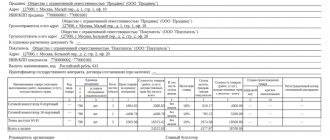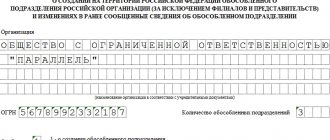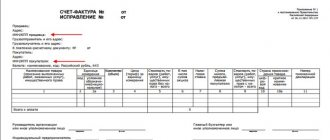Separate divisions (branches) are not VAT taxpayers and do not have their own Taxpayer Identification Number (Clause 1, Article 143 of the Tax Code of the Russian Federation). Therefore, all VAT payable to the budget is transferred to the location of the parent organization. The VAT return is also drawn up for the organization as a whole and submitted to the tax authority at its location.
The fate of VAT deduction from the buyer depends on how correctly the invoice (IF) received from the branch is filled out. In this article we will look at the features of issuing invoices by a separate division if it:
- received an advance;
- shipped the goods;
- provided services and performed work.
Peculiarities
More information about how and what details should be indicated in various types of invoices can be found here.
Numbering
Primary requirements:
- numbers must be sequential;
- numbering ascending;
- eliminating the possibility of drawing up two invoices with the same numbers in different departments.
The taxpayer has the right to choose the order in which invoice numbers are issued, as well as the period from which numbering begins (year, quarter, month).
Letter of the Ministry of Taxes and Taxes of the Russian Federation 05.21.2001 N VG-6-03/404 “On the use of invoices when calculating value added tax” establishes the principles for numbering OP invoices, which allows solving this problem in two ways:
- Creation of number reserves for each department.
- Adding an internal department index to the number.
Read about what invoice numbers are here.
Acceptance of VAT for deduction on purchases from branches
VAT is accepted for deduction if the conditions are met (clause 2 of Article 171 of the Tax Code of the Russian Federation):
- goods purchased for activities subject to VAT;
- in stock - correctly issued SF (UPD);
- goods are accepted for accounting (clause 1 of article 172 of the Tax Code of the Russian Federation).
Acceptance of VAT for deduction is reflected in the Purchase Book. When receiving SF from a separate division, the entry in the Purchase Book will have the following features:
- Seller's name , gr. 9 - parent organization;
- INN/KPP of the seller , gr. 10: TIN - data of the parent organization;
- Checkpoint - data of a separate unit.
Is it possible to deduct VAT on the Northern Federation if the checkpoint of the parent organization is indicated instead of the checkpoint of a separate division?
It is possible (clause 2 of article 169 of the Tax Code of the Russian Federation, clause 2 of article 171 of the Tax Code of the Russian Federation, clause 1 of article 172 of the Tax Code of the Russian Federation). Specifying the checkpoint of the parent organization instead of the checkpoint of the branch does not prevent the Federal Tax Service from identifying the supplier and is not a significant error leading to a refusal to deduct VAT.
In the VAT return in Section 9 “Information from the sales book” the seller does not indicate information about the checkpoint of a separate division. Therefore, there is no checkpoint reconciliation in the VAT return.
Still, we do not recommend making obvious mistakes and accepting incorrect primary products from suppliers. If the SF from the branch indicates the checkpoint of the parent organization, then ask for a replacement document and protect yourself from possible quibbles of controllers.
According to the rules for filling out the Purchase Book, the checkpoint that is indicated on the invoice must be filled out. Therefore, if the SF indicates the checkpoint of a separate division, then it is this that should be reflected in the Purchase Book and in the VAT return in Section 8.
See also:
- Purchasing goods from a separate division with delivery costs included in their price
- The procedure for filling out the directory element Counterparties. Features of filling. Separate division
Did the article help?
Get another secret bonus and full access to the BukhExpert8 help system for 14 days free of charge
Related publications
- Document Invoice received In this article we will talk about the purpose of the document Invoice received. Let's find out...
- How to create purchase and sales books in 1C 8.3 step by step Formation of purchase and sales books in 1C 8.3 -...
- Accounting for the costs of delivery of purchased goods, which are accounted for separately and are not included in their cost. Transportation and procurement costs are associated with the procurement and delivery of material assets: raw materials,…
- Transition from 18% to 20% VAT: recommendations, examples, questions and answers 2021 is ending, which means the moment is inexorably approaching when everyone...
Exhibition rules
- Registration of an invoice (hereinafter referred to as S-F) in the sales book.
- S-F itself is discharged only after:
- shipment of goods;
- acceptance by the customer of the work or service;
- after receiving the advance.
- An invoice can be issued both in paper and electronic form, while the issuance of an electronic invoice occurs through a special organization - an electronic document management operator (clause 1.3 Order of the Ministry of Finance of the Russian Federation dated November 10, 2015 N174N).
- The paper document is printed in two copies for the buyer and the seller (a standard invoice form in Word and Excel format for printing a paper document can be found here).
- The period for issuing is limited to 5 days from the date of shipment and receipt of the advance payment (you will learn about the time frame within which an invoice must be issued to the buyer in this material).
The following publications from our experts will help you fill out your invoice correctly:
- What is a document code?
- How to correctly issue an invoice for an advance payment, for services, as well as for the return of goods to the supplier?
Results
An invoice is an important tax accounting document on the basis of which the buyer has the right to claim VAT for deduction. To legally reduce the tax payable to the budget, the document must be drawn up on an up-to-date form with all the necessary details filled in, and it must also contain no errors critical to the deduction.
An incorrect checkpoint is not a significant error, since it allows the identification of the seller or buyer.
Therefore, in such a situation, the recipient of goods (works, services, etc.) can exercise his right to deduction without any risks. You can find more complete information on the topic in ConsultantPlus. Free trial access to the system for 2 days.
Decor
- In the line “Invoice No.” the serial number of the document is placed, and the department index is added to it.
- The date of formation of the Federation Council is indicated. The date in the invoice should not appear later than the date specified in the primary documentation (accounting journal).
- The “Correction” line is filled in only if corrections are made, and the date and number of the correction are indicated.
- In paragraph (2) “Seller” the name of the organization for which the OP is indicated. Example: Good Products LLC.
- Paragraph (2a) “Address” must contain the address of the seller, that is, the organization.
- Paragraph (2b) contains the TIN of the organization, but the checkpoint contains the TIN of a separate unit. Difficulties most often arise in filling out this item.
- Item (3) “Consignor” contains information about the remote unit, its name and address.
- Paragraph (4) “Consignee and his address” indicates the name and address of the company to which the goods were shipped, or its remote division.
- Paragraph (5) “To payment document No.” – enter the number of the payment documentation to which the SF is attached.
- In Clause (6) “Buyer” the name of the organization purchasing the goods is entered.
- Item (6a) “Address” contains information about the address of the purchasing organization.
- Paragraph (6b) “TIN/KPP - if the goods are sent to the buyer’s OP, then this line indicates the TIN of the organization itself and the KPP of the unit. If the Buyer and the Consignee are in the same place, then the organization’s checkpoint is written.
- Clause (7) “Currency: name, code.” You can see the code and name of the currency in the Decree of the State Standard of Russia dated December 25, 2000 N 405-st. Example: Russian ruble, 643. You can find out whether it is possible to issue an invoice in the currency of another country, where to find out and display such a code, from our special material.
- Next, a table is filled in with the listing and specification of the goods being shipped, its price, the amount of tax charged to the buyer, etc. The procedure for filling out the table is common for both the OP and for shipment directly from the parent organization.
- At the end of the document the signatures and stamps of the manager and chief accountant are affixed. In the situation of issuing an invoice by a remote unit, the head of the OP is required to have a power of attorney to sign it and affix stamps on behalf of the organization. The authorized representatives put their signatures in the lines “Head of the organization” and “Chief accountant”; next to it is written the transcript of the signature and the position of the signatory.
Checkpoint of the largest taxpayer: where to see the assigned code
To confirm the fact of registration of the organization, a notification is issued, which indicates the checkpoint assigned to the payer. The document must be drawn up in accordance with Form No. 9-KNU, approved by Order of the Federal Tax Service of the Russian Federation No. SAE-3-09 / [email protected] dated April 26, 2005.
However, this notification may not always be at hand. How to find out the checkpoint of the largest taxpayer in this case?
Using the TIN assigned to the business entity - on the official website of the Federal Tax Service of the Russian Federation or special online services, by entering the TIN of the organization, you can obtain the registration data of the desired object.
How is the document presented if the branch is foreign?
In the situation of a division of a foreign company, the following scenarios are possible:
- If the foreign company that owns the OP is registered in the Russian Federation and is a tax payer, then the entire procedure for issuing the SF is consistent with Article 21 of the Tax Code of the Russian Federation and is similar to that given above.
- If a foreign company is not registered in the Russian Federation, but has branches on its territory, then it can pay VAT through a tax agent. This applies to those companies that do not have official representative offices, but enjoy the right to register with the Federal Tax Service to pay VAT.
- If a foreign organization has a permanent establishment in the Russian Federation, then paying VAT becomes its responsibility. In this case, in lines (2) “Seller”, (2a) “Address” and (2b) “TIN/KPP” the information of the permanent representative office of the foreign enterprise is indicated. If the representative office is not the shipper, then the checkpoint is introduced as a separate unit. (Letter of the Ministry of Finance of the Russian Federation dated April 30, 2008 No. 03-07-11/171.
Cash desk of a separate division
If cash transactions are carried out in a separate division, then it is obliged to maintain a cash book.
This must be done on the basis of paragraph 9, clause 2.5 of the Bank of Russia Regulations dated October 12, 2011. No. 373-P “On the procedure for conducting cash transactions with banknotes and coins of the Bank of Russia on the territory of the Russian Federation”, in accordance with which:
- sheets of the cash book of a separate division are selected and bookleted by a legal entity for each separate division.
According to clause 5.2 of Regulation No. 373-P, entries in the cash book are made by the cashier for each incoming and outgoing cash order issued for cash received and issued.








